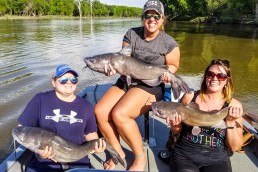Water Temperatures and Catfish
SHARE THIS POST
Everything a catfish does in their lives is based on water temperature, which is why Brad Durick has learned to identify changes and make subtle adjustments to stay on fish.
Everything a catfish does in life is based on water temperature. As we all know, fish are cold-blooded creatures which means their body temperature follows the water temperature. This seems pretty obvious if you paid attention in grade school science, but many seem to forget how sensitive to water temperature fish really are.
Each season of a catfish’s year is triggered by changes in water temperature. Pre-spawn begins when the water temperature reaches about 50 degrees. Spawn kicks in at 70 degrees. The fall pattern begins when the water temperature drops back to the low 60s.
A quick overview of the sun and temperature
Taking this a step deeper, the water temperature and seasons are directly related to the sun and warming hours that the sun provides. This part is obvious but there are variables in water temperature that are related more to weather.
In the reverse, the water begins cooling later in the summer and into early fall, even though it is still nice, and in some cases hot outside. The warming hours are less and hours under darkness are greater, forcing the water temperatures to fall.
Weather variables
There are always variables in weather that will cause water temperature swings. Cold fronts or heat waves that roll in and cause rapid changes to water temperature. Both can affect fish and how they act for a day or two, or even bring about long-term change.
Like everything else in fishing, sometimes just a small adjustment can help you fish your way through these variables and make the most of your day on the water.
Fishing through water temperature changes
We know that water temperature changes throughout the year and during different weather patterns. So, how do you fish to changes in water temperature?
Are you enjoying this post?
You can be among the first to get the latest info on where to go, what to use and how to use it!
In the spring, as water temperatures rise into the mid-50s and 60s, the fish will get more aggressive and start to feed along the main current seams of rivers. Unless the water level is high the fish will move right on the seam and in the faster current areas.
When the water temperature falls from a cold front, or a sharp water fluctuation, the catfish will move just out of the current. In many cases, you can fish almost the same spots, but you need to get out of that main current seam.
If the water temperature rises or falls sharply say 10 to 15 degrees in just a few days the fish will get moody and move off the current. In this case you need to look for structure and current breaks that catfish use to hide and expend the least amount of energy. Sometimes this will last a couple days to a couple weeks depending on how sharp the temperature rise is.
During the midsummer when catfish are not migrating as much they will stick to holes and structure. The same rules as before apply. If the water temperature is stable to rising the fish will be feeding more aggressively at the heads of holes and in outside of snags. Should the water temperature drop from a front or something the fish will move tighter to the wood or more to the middle of the hole. In this case you may have to sit on them a little longer to catch the best fish.
When fall begins, there is a different phenomenon that happens. The catfish will actually turn on knowing that winter is just around the corner. As long as the temperature is somewhat stable, they will feed and if there is good flow in the river, they will pattern just like spring. The fish will be hunting but if there is a cold front that drops the temperature really quickly, they will move off the current, but right next to it, just like spring.
When there is a nice sunny day, just enough to warm the surface even a degree, the catfish will come out to play with aggression. Stay on the move, and keep the bait fresh, because it may be one of the last great days.
Want some more great fall fishing information? Read the September issue of MidWest Outdoors, available the first full week of September at the newsstand or by subscribing on our website.
MWO
SHARE THIS POST
You may also like...
Nothing found.
Did you enjoy this post?
You can be among the first to get the latest info on where to go, what to use and how to use it!
Brad Durick
Captain Brad Durick is a nationally recognized catfish guide, seminar speaker, and author of the books Cracking the Channel Catfish Code and Advanced Catfishing Made Easy. For more information: redrivercatfish.com or facebook.com/braddurickoutdoors.
